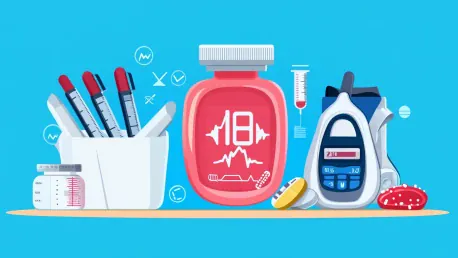The potential application of GPT-4, a large language model (LLM), in simplifying diabetes management by accurately interpreting continuous glucose monitoring (CGM) data and generating actionable insights is a promising development in healthcare. Researchers have been exploring innovative ways to mitigate the complexities associated with diabetes care, especially given the challenges both clinicians and patients face. The study described in this article investigates how effectively GPT-4 can handle these tasks and the implications for clinical practice in diabetes care.
The Complexity of CGM Data Interpretation
Continuous glucose monitoring systems provide real-time data on glucose fluctuations, crucial for managing diabetes. These systems enable the calculation of various metrics like mean glucose levels, glycemic variability, and time spent within specific glucose ranges, essential for informing crucial clinical decisions. However, the complexity of interpreting such detailed information often poses significant challenges for both patients and healthcare providers. Traditional methods, such as software-generated ambulatory glucose profiles, while informative, can be intricate and overwhelming for patients to comprehend properly.
Additionally, there is often variability among clinicians in interpreting CGM data, which can affect treatment decisions and patient outcomes. This inconsistency can arise from different levels of experience or differing interpretations of the same dataset. The study in question aims to address these challenges by leveraging GPT-4’s capabilities, providing a consistent, accurate, and accessible means of interpreting CGM data for both clinicians and patients. This innovative approach has the potential to bridge the gap between complex data and practical, clear insights that can significantly enhance diabetes management.
Study Design and Methodology
The study, published in the journal Scientific Reports, involved researchers from the United States who evaluated GPT-4’s performance in calculating essential glucose metrics and producing descriptive summaries based on CGM data. By employing a thorough and structured research methodology, the study’s design incorporated two main parts: a quantitative metric evaluation and a qualitative data summarization. This dual approach ensured a comprehensive assessment of the model’s capabilities.
For the quantitative analysis, GPT-4 was prompted to calculate standardized CGM metrics such as mean glucose, glycemic variability, and time spent in specified glucose ranges. The outputs generated by GPT-4 were then meticulously compared to ground truth values to assess their accuracy. In parallel, the qualitative evaluation focused on GPT-4 generating narrative summaries in five specific categories: hypoglycemia, hyperglycemia, glycemic variability, data quality, and primary clinical takeaways. Two independent clinicians were tasked with evaluating these narratives for accuracy, completeness, safety, and suitability, lending a robust and unbiased perspective to the results.
Quantitative Analysis: Accuracy of Metric Computations
Key findings from the quantitative analysis revealed that GPT-4 accurately performed nine out of ten metric computations across ten cases, demonstrating its potential to handle complex data with precision. Variability in calculation errors was mainly due to ambiguities in prompt definitions, particularly concerning the threshold for “time above 180 mg/dL.” These minor errors did not significantly detract from the overall success of the model in providing correct metric calculations, underscoring the efficacy of GPT-4 in automating data interpretation.
The significance of GPT-4’s accuracy in calculating these metrics lies in its potential to reduce the burden on clinicians, who often spend considerable time analyzing and interpreting extensive CGM data. By automating these processes, GPT-4 can enhance the consistency and reliability of data interpretation, leading to more informed and timely clinical decisions. This automation could ultimately lead to better patient outcomes, as clinicians can focus more on direct patient care and less on the manual interpretation of complex data sets.
Qualitative Analysis: Generating Narrative Summaries
For the qualitative tasks, GPT-4 effectively produced narrative summaries, earning high ratings from clinicians for accuracy, completeness, and safety, with average scores ranging from 8 to 10 out of 10 across various categories. These high scores indicate that the model is capable of generating useful, accurate summaries that can aid clinicians in making informed decisions. However, some limitations were noted during the evaluation process, highlighting areas where further refinement is necessary.
GPT-4 occasionally overstated concerns related to hyperglycemia and sometimes misinterpreted trends, such as categorizing euglycemic periods as prolonged hyperglycemia. These errors could potentially lead to misguided clinical decisions if left unaddressed. Additionally, there were instances where the model did not prioritize significant clinical metrics, like time in range or Glucose Management Indicator (GMI), when summarizing overall glucose control. While these findings suggest that GPT-4 can generate useful summaries, further refinements are necessary to ensure the accuracy and clinical relevance of the information provided.
Implications for Clinical Practice
The study highlighted that while GPT-4 synthesized complex CGM data into accessible summaries, some improvements were necessary to enhance its utility in clinical practice. The researchers suggested refining prompt definitions and incorporating better error-handling mechanisms as key strategies to improve the model’s clinical significance. It was also noted that addressing issues like missing nocturnal hypoglycemia, which is critical for patient safety, would be paramount in ensuring the model’s successful integration into healthcare workflows.
Overall, the study emphasized the promise of using large language models in diabetes management. GPT-4 demonstrated significant potential in automating CGM data analysis and generating summaries that could complement clinical workflows, potentially leading to more streamlined care processes. However, further refinements and validations would be essential to ensure the safety, effectiveness, and widespread clinical adoption of such models. By addressing these concerns, GPT-4 can transition from a promising innovation to an indispensable tool in diabetes care.
Future Directions and Potential Benefits
The study discussed in this article examines how effectively GPT-4 can manage these tasks and its potential impact on clinical practice in diabetes care. By harnessing the power of GPT-4, there is hope for a more streamlined approach to diabetes management, potentially improving outcomes for many patients. The integration of advanced AI like GPT-4 into healthcare systems represents a significant step forward, offering the possibility of more personalized and efficient care. This development could transform the way diabetes is managed, making it easier for patients to maintain their health and for clinicians to provide optimal care.









